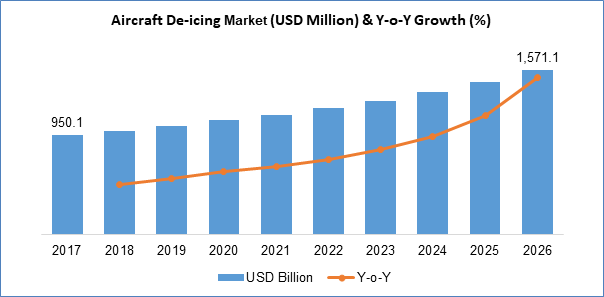
Aircraft De-icing Market Share, Size, Trends, & Industry Analysis Report, By Fluid Type (Type-I, Type-II, Type-III, Type-IV); By Product Type (Sweepers, De-Icing Trucks, De-icing Chemicals and Fluids); By End-User (Commercial Aircrafts, Military Aircrafts); By Region and Segment Forecast, 2019 - 2026
- Published Date:Mar-2019
- Pages: 101
- Format: PDF
- Report ID: PM1584
- Base Year: 2018
- Historical Data: 2015-2017
Report Summary
The global aircraft de-icing market was valued at USD 993.7 million in 2018 and is anticipated to grow at a CAGR of 6.1% during the forecast period. De-icing is the process that ensures the aircraft’s critical surfaces such as the wings, tail, nose, radar equipment, horizontal stabilizers and vertical stabilizers, is free from frost, ice, snow and other frozen contaminants. Apart from adding extra weight, the ice and snow on the aircraft fuselage disturbs the flow of air, thereby reducing lift. Frozen contaminants are also capable of disrupting the movement of the wing flaps and ailerons.
The de-icing fluids are categorized into Type I, Type II, Type III, and Type IV. The type I de-icing fluid is combined with water in a 55:45 mixture, has low viscosity, and provides short-term protection. Type II is used for larger aircrafts, is mixed in a 75/25 percent with water, and is applied at about 80°C. Type III fluid is used on slower aircrafts, and are generally light yellow in color. Type IV fluids has high viscosity, must be applied onto a clean surface, and is green in color.

Know more about this report: request for sample pages
The growing air traffic coupled with rising need to offer an improved and comfortable traveling experience to passengers primarily drives the market for Aircraft De-icing. The increasing instances of flight delays during winters have accelerated the market growth. The increasing security concerns, along with stringent regulations regarding the proper operation of aircrafts propel the market growth. The modernization of existing air terminals, and increasing investment in technologies to provide safety and comfort to passengers are factors expected to provide growth opportunities to the market during the forecast period. The growing technological advancements in the aviation sector, modernization of old airports, and evolving regulatory mandates in several countries would drive the market growth during the forecast period.
Segment Analysis
The global aircraft de-icing market report segments the market on the basis of fluid type, product type, end-user, and geography. Based on the fluid type, the market is segmented into Type I, Type II, Type III, and Type IV. Type I fluid has a low viscosity, and provides only short-term protection. It is sprayed on hot surfaces at high pressure to remove snow, ice, and frost.
The product type segment in the global Aircraft De-icing industry is categorized into sweepers, de-icing trucks, de-icing chemicals and fluids, and others. The end-user segment in the global Aircraft De-icing industry is categorized into commercial aircrafts, and military aircrafts. The commercial aircrafts accounted for the highest market share in 2018 in the global market owing to increasing air traffic and growing safety concerns.
Aircraft De-icing Market Scope
By Fluid Type |
By Product Type |
By End User |
By Region |
|
|
|
|
Know more about this report: request for sample pages
Regional Analysis
This report comprises a detailed geographic distribution of the market for Aircraft De-icing across North America, Europe, Asia-Pacific, Latin America, and MEA. North America is further segmented into U.S., and Canada. Europe is divided into Germany, UK, France, Italy, Spain, Belgium, Russia, Netherlands, and Rest of Europe. Asia-Pacific is bifurcated into China, India, Japan, Korea, Singapore, Malaysia, Indonesia, Thailand, Philippines and Rest of Asia-Pacific. North America dominated the global market in 2018 owing to the harsh weather conditions and high amount of snow in winter months. The rising air traffic, and growing concerns regarding passenger safety support the market growth in this region.
Competitive Landscape
The vendors in the aircraft de-icing market are launching new products to meet the growing customer needs. In addition, the leaders in the market are acquiring and collaborating with top companies in the market to enhance their offerings in the market and expand their customer base. The Aircraft De-icing industry is highly competitive with the presence of many small and large vendors. The leading players in the report include BASF Corporation, Global Ground Support LLC, UTC Aerospace Systems, The Dow Chemical Company, Vestergaard Company A/S, Weihai Guangtai Airport Equipment Co, B/E Aerospace, Inc., Clariant AG, Kilfrost Corporation, and Honeywell International Inc.
License and Pricing
Purchase Report Sections
- Regional analysis
- Segmentation analysis
- Industry outlook
- Competitive landscape
Connect with experts
Suggested Report
- Smart Glass Market Share, Size, Trends, Industry Analysis Report, 2021 - 2028
- Textile Chemicals Market Research Report, Size, Share & Forecast by 2017 - 2026
- Migraine Drugs Market Share, Size, Trends, Industry Analysis Report, 2022 - 2030
- Bone Grafts and Substitutes Market Size, Share & Trends Analysis Report, 2021-2028
- Inspection Camera System Market Share, Size, Trends, Industry Analysis Report, 2022 - 2030

